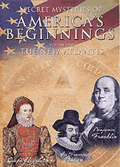THE
FOUR CARDINAL ERRORS THAT ALMOST DESTROYED AMERICA
PART 1
By Professor
Steven Yates
September 13, 2009
NewsWithViews.com
Four Cardinal Errors, as I will call them, have all but destroyed our original Republic, dating from July 4, 1776 with the Declaration of Independence. Error One: the Republic failed to gain full freedom and economic sovereignty from the British Crown, and this state of affairs went unrecognized. Error Two: the country adopted an educational system whose premises were alien to those of a free Republic. Error Three: Americans slowly but steadily lost the “moral religiosity” of its founding traditions, replacing it with a naturalistic materialism also imported from Europe. Error Four: Americans did not recognize the British Fabian Society for what it was, and stayed blind as agents of Fabian permeation gradually assumed control over dominant institutions and occupations in this country. This paved the way for the piece-by-piece erosion of our sovereignty and its replacement by world government (“global governance”).
The first of these will doubtless come as something of a surprise. Please allow me to elaborate. (The second, third and fourth will be dealt with in future installments.)
Cardinal Error One. Our Republic, founded in 1776, failed to retain its full freedom and economic sovereignty from the British Crown—which had long been the wealthiest and most powerful secular entity in the Western world. (See E.C. Knuth, The Empire of the City: The Secret History of British Financial Power, orig. 1944).
I.
Concentrations of power have always been dangerous. This can be as true of private wealth as it is state power; when used to buy and retain the loyalty of heads of state, private wealth is power. Such a system was built up gradually by the Rothschild dynasty in the final third of the 18th century. Mayer Amschel Bauer had been a child prodigy of sorts, growing up in Frankfort-on-the-Main and learning the art of moneylending from his father, Amschel Moses Bauer. The elder Bauer had started a counting house and hung a red shield over the entrance. The Bauers were Ashkenazi Jews, and the red shield was a revolutionary symbol. Young Amschel Mayer’s parents having died from the plague, he was sent to Hanover to work in a major bank. His talent obvious, he became a partner when still in his teens. He returned to Frankfort and bought the family business back. The red shield was still there. He changed his last name to Rothschild (Rott schild = red shield), offered his services as a dealer in rare coins to local heads of state, and as a moneylender. He was soon on his way to becoming fabulously wealthy. He would move with his family into a house shared with the Schiffs, another fabulously wealthy banking dynasty whose most famous progeny would be Jacob Schiff.
Mayer Amschel Rothschild had five sons and five daughters. He trained each son in the science of moneylending, and eventually placed each in a central bank in a major city in Europe: Amschel Mayer stayed in Frankfurt, Salomon Mayer went to Vienna, Nathan Mayer went to London, Kalmann (Karl) Mayer went to Naples, and Jacob (James) Mayer went to Paris. Remaining in close communication, the five Rothschild sons became the first internationalists whose only loyalties were to money, power, and the Rothschild name. Central bankers had adopted fractional reserve banking, the art and science of lending more money than the bank had in reserve—in effect, creating money out of thin air—and then charging interest on it. This had proven to be a road to riches previously undreamt of! Mayer Amschel Rothschild has been quoted: “Allow me to issue and control a nation’s money, and I care not who makes the laws.”
Each Rothschild daughter, meanwhile, married into another wealthy banking house, extending Rothschild influence but without using that name. Within a couple of generations, there were people advancing Rothschild causes who very likely had no idea who they were working for.
The British Crown was, as we already noted, one of the largest repositories of wealth and power in the West. The Crown’s Dutch East Company spanned the globe. It was inevitable that the most talented of the Mayer Amschel’s sons—Nathan Mayer—would establish his bank (N.M. Rothschild & Sons) in the hoary City of London, the heart of Crown territory. Soon, Rothschild influence also spanned the globe.
II.
The colonies established in North America were intended to be commercial entities serving the Crown. The colonists eventually began to chafe at the fact that they were not treated the same as other British citizens. Contrary to what many history books teach, they did not initially want independence from the British Empire. ‘Taxation without representation,’ for example, was obviously not a demand for independence but for equal treatment under British law. Their demands met with no response from King George III, who in 1775 proclaimed the colonies to be in rebellion. (Note that word proclaimed. We will see it again.) By the end of the year, independence stirrings had begun. In early 1776, Thomas Paine published Common Sense. Paine’s tract brazenly attacked the very institution of monarchy and made an eloquent case for independence over reconciliation: “The authority of Great Britain over this continent, is a form of government, which sooner or later must have an end …” And later: “A government of our own is our natural right.” Common Sense was widely read throughout the colonies. A Declaration of Independence was inevitable, as was the war for independence which followed.
Thirteen colonies became a Perpetual Union of sovereign states under the Articles of Confederation—a document creating a highly decentralized society rooted in the assumption that concentrations of power are dangerous. By the mid-1780s, however, the elites within the states were grousing that the federal government established under the Articles was too weak—and to be sure, a number of volatile issues both within and between the states had erupted which it was unclear could be resolved peacefully under the authority of the Articles. It wasn’t clear that the Perpetual Union established under the Articles was sustainable. In 1787 the states sent representatives to the first Constitutional Convention, which met behind closed doors. Its stated purpose was to revise the Articles of Confederation. But why the secrecy? This raised red flags even then.
The representatives emerged after three months with an entirely new document, the Constitution of the United States of America. When asked by a woman what kind of government this Constitution created, monarchy or republic, Benjamin Franklin famously replied, “A Republic, if you can keep it.” One thing was for sure: the Constitution had created a stronger central government than its predecessor. It is unfortunate that Thomas Jefferson had been in Europe while this was going on. Had he participated in the Constitutional Convention, it is at least possible that the resulting Constitution and all subsequent history might look very different.
To be adopted, the new Constitution needed ratification by nine of the thirteen states. James Madison, John Jay and Alexander Hamilton penned The Federalist Papers making a public case for ratification. Others—whom history labels the “Anti-Federalists”—smelled a rat and argued against the Constitution’s ratification. Authors such as Richard Henry Lee and Robert Yates (no known ancestral relation to the present author) among others circulated numerous statements contending, among other things, that the Constitution contained too many loopholes which those who wanted a still larger central government would eventually climb through. Among their worries was the lack of an explicit statement of people’s natural rights which the federal government was obligated to respect. Statesmen like George Mason paid attention. A compromise was reached: a Bill of Rights (first ten amendments to the Constitution) was inserted.
In light of history, this wasn’t enough. History has validated the fears of the “Anti-Federalists.” But alas, we get ahead of ourselves.
The Constitution created a new system of government, one stronger and more centralized than that of the Articles but still limited. The federal government was to have three branches, each with specific delegated powers—or, better, responsibilities, since the overriding aim of having a Constitution was to contain power by creating a balance of powers within the federal government itself; and with dual sovereignty—the central concept of true federalism in which the powers of the federal government were few and carefully defined while the rest was left to the states (Ninth and Tenth Amendments).
Among the responsibilities assigned to Congress was to “coin money and regulate the value thereof.” Article I Section 8 did not authorize Congress to delegate this responsibility to any private entity or public-private partnership. This clause in the Constitution was abrogated almost at once by Thomas Jefferson’s arch foe Alexander Hamilton, allowed to create the first Bank of the United States over Jefferson’s explicit objections. Jefferson’s warnings about central bankers, doubtless based on first hand observations from his time in Europe, are well known.
It is likely that the European banking elite—centered in dynasties such as that of Rothschild and Schiff—wanted to destroy the fledgling Republic across the ocean right from the start. They would bring it under their control, or else! The Treaty of Paris of 1783 had officially ended the war, but His Brittanick Majesty’s overbearing presence remained, including on U.S. soil. President George Washington, seeking to avoid renewed hostilities with the still-powerful British war machine, sent John Jay to London to work out a new treaty that would diffuse the danger of renewed conflict. This treaty—virtually forgotten by historians today—became known as the Jay Treaty and was very controversial in its time. It was signed in London on November 19, 1794. Back in the states, it was submitted to our Senate on June 8 the following year and provoked an angry and rancorous debate. It was finally passed on June 24 (the vote was 20 – 10). The House passed it on August 14, 1795. Then it was sent back to the British. Great Britain ratified it on October 28, 1795; His Brittanick Majesty proclaimed it on February 29, 1796.
Time out! Remember that word proclaimed? What, precisely, do we mean, proclaimed? There was no basis for a recognition of proclaimed in the Constitution! Proclaiming was something done by British royalty, not Constitutional Republics!
What this means is bound to be startling, even to Patriots who believe they’ve seen everything! In the last analysis, given that it was proclaimed, the Jay Treaty is more a British document than an American one. His Brittanick Majesty ended the American War for Independence on February 29, 1796—with a treaty that does not explicitly assent to U.S. sovereignty and independence. Rather, it establishes “a firm inviolable and universal Peace, and a true and sincere Friendship between His Brittanick Majesty, His Heirs and Successors, and the United States of America …” Had Americans just fought a war for independence only to have established an ambiguous “Friendship” with the Crown, one that is “inviolable”?
The disturbing question that should pull us all out of our comfort zones: in this last analysis, did the United States of America remain, however covertly, under the thumb of the British Crown? Were Americans merely allowed to believe they had attained full sovereignty?
A final note about the Jay Treaty. Its Articles V, VI and VII of the Jay Treaty establish the first international mixed commissions, to resolve disputes not yet resolved through negotiation. This set an important precedent for later “commissions of inquiry” with autonomous decision-making power.
III.
Remember that Alexander Hamilton’s Bank of the United States was in operation by this time. Hamilton had defended what amounts to mercantilism in Federalist #12. Unlike Jefferson and the “Anti-Federalists” he wanted a centralized and activist government. Was Hamilton secretly working for the Crown, and therefore also for the Rothschilds? His goals aligned with theirs, and the future was open to the very meddling by European bankers about which Jefferson was warning everyone who would listen. A few historians believe Nathan Meyer Rothschild ordered the War of 1812 as punishment for our refusal to recharter Hamilton’s bank (so much for the “inviolability” of the Friendship Treaty from the Crown’s point of view). Wars, of course, create debt; central banking, to create the money to pay the debt, becomes an irresistible temptation. The Second Bank of the United States was chartered in 1816. Rothschild agents John Jacob Astor, Stephen Girard, and David Parish were placed in charge. With Nathan at the helm, the Rothschilds ascended to full power during the first two decades of the 1800s—especially with the insider-trading stunt he pulled with the Battle of Waterloo which made him Great Britain’s richest man.
President Andrew Jackson—a hero of that war following his victory in the Battle of New Orleans—would shut down the Second Bank of the United States having denounced the institution as “a den of vipers and thieves.” This was the culmination of his protracted battle with Rothschild agent Nicholas Biddle, who had assumed the Bank’s presidency in the 1820s. The bankers retaliated by causing a near-depression that severely damaged the remainder of Jackson’s presidency. He would survive an assassination attempt on January 30, 1835. His would-have-been assassin admitted working for “foreign interests.”
While we had no central bank during the decades which ensued, we also had no means to prevent Rothschild meddling in American affairs. For example, Rothschild agent August Schoenberg came to our shores and changed his last name to Belmont. He began purchasing government bonds, rose in wealth and stature through his firm August Belmont & Co., and eventually became an advisor to the White House. John Slidell, another Rothschild agent, had been a merchant in New York before relocating to New Orleans to build up a law practice. He would serve in the Louisiana House of Representatives. Finally, Judah Benjamin was a Rothschild agent who would rise to become Jefferson Davis’s chief advisor. Yes, we now have pretty good evidence that the attempt to divide the U.S. in two was a Rothschild scheme from the get-go. The emerging battle over slavery served as a convenient issue on which to focus public attention. Those with real power couldn’t care less about such things as the treatment of minority groups unless it creates a wedge issue they can use.
Fractional money flowed into the coffers of corporations that built the industrial revolution that transformed the Northern states during the second third of the 1800s. This process took people off the land they had farmed and sent them into burgeoning cities. It created a fundamentally different culture. Invariably, people began to lose touch with the land and would eventually lose the ability their ancestors possessed to live off the land. The North’s commitment to industry versus the South’s preference for an agrarian economy also helped set the stage for dividing America into two separate nations that could be more easily brought under Rothschild/Crown control.
Was the most violent war ever fought on U.S. soil really orchestrated from overseas, or is this just a “conspiracy theory”? Consider what Otto Bismarck (a protégé of Frankfort’s Amschel Mayer Rothschild) would say in 1876: “The division of the United States into federations of equal force was decided long before the Civil War by the high financial powers of Europe. These bankers were afraid that the United States, if they remained in one block and as one nation, would attain economic and financial independence, which would upset their financial domination over the world. The voice of the Rothschilds prevailed… Therefore they sent their emissaries into the field to exploit the question of slavery and to open an abyss between the two sections of the Union.”
Abraham Lincoln thwarted the division of the U.S. into two separate nations—and kept the nation out of debt to foreign bankers by printing Greenbacks. He’d had to sign a National Banking Act (1863) as a wartime measure, however, and this was a step back toward a central bank. Some recent treatments of Lincoln portray him as a ruthless and unscrupulous tyrant (see, e.g., Thomas DiLorenzo’s The Real Lincoln, 2002). In a sense, he was between a rock and a hard place. By using brute force to bring the Confederacy back into the Union he thwarted the Rothschild scheme but there was a steep price: the end of dual sovereignty and hence of true federalism. The federal government ascended to its present status as dominant over the states. The consolidation of federal power (which should have become known as central power) proved to be permanent. The South, ravaged by war, descended into poverty. For all this, there are Southerners who have never forgiven Lincoln. On the other hand, had he allowed Southern secession to stand, this would have given the Rothschilds what they wanted—and heralded an uncertain future for both societies in which neither would have enjoyed what sovereignty they had for very long. Lincoln seems to have known what was really going on. In an 1865 statement he told Congress, “I have two great enemies, the Southern Army in front of me, and the financial institutions in the rear. Of the two, the one in my rear is my greatest foe.”
Lincoln made other remarks suggesting that he believed his life would end violently, with an assassination. He knew he had made enemies who had no scruples about murdering those who interfered with their plans. Not long before his assassination he wrote: “The money power preys upon the nation in times of peace and conspires against it in times of adversity. It is more despotic than monarchy, more insolent than autocracy, more selfish than bureaucracy. I see in the near future a crisis approaching that unnerves me and causes me to tremble for the safety of my country. Corporations have been enthroned, an era of corruption in high places will follow, and the money power of the country will endeavor to prolong its reign by working upon the prejudices of the people until the wealth is aggregated in a few hands and the Republic is destroyed.”
|
Subscribe to the NewsWithViews Daily News Alerts! |
Suffice it to say: a major treaty ending our initial conflict with Great Britain in the late 1700s was proclaimed (not simply signed or ratified). The money that grew U.S. industry in the 1800s came from Great Britain—a great deal of it came specifically from that powerful family ensconced in the City of London: the Rothschilds. The effort to divide the nation also appears to have emanated from the Rothschild/Crown axis. Even though the Rothschild/Crown axis lost that battle, the question remains: was our Republic ever truly sovereign and free of Rothschild/Crown interests? It appears not! To be sure, we believed we were free. We generally acted as if we were free! But were we merely allowed to believe we were free while in truth remaining the Crown’s biggest covert colony? For part two click below.
Click here for part -----> 1, 2, 3,
� 2009 Steven Yates - All Rights Reserved















